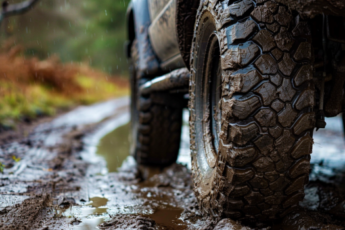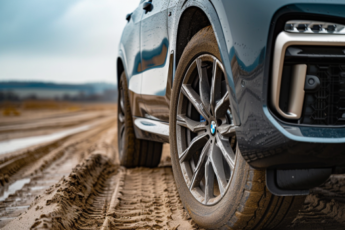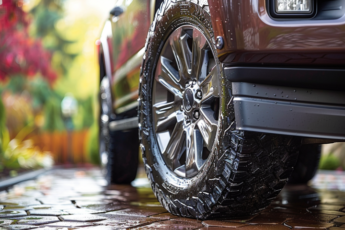Last Updated on 2 weeks
Maximizing Performance with the Right Tires in Lawn Care
As professional landscapers and lawn care specialists, choosing the right garden equipment tire is crucial for the performance of your tools and overall work efficiency. With the demanding nature of transporting heavy equipment like mowers, trailers, and tractors, selecting the proper landscaping equipment tire ensures durability and helps you get the job done quickly. The right garden machinery tire and maintenance practices can significantly prolong the lifespan of your yard equipment, saving you time and money in the long run.
Key Takeaways
- You are selecting the correct tire size, tread design, and construction for your garden equipment.
- It is understanding the basics of garden and lawn equipment tires.
- Factors to consider when choosing tires for different terrain and equipment.
- You are maintaining your tires for optimum performance and longevity.
- Recognizing signs of wear and tear on your garden equipment tires.
- It is knowing when to repair or replace your tires.
- You are finding and sourcing high-quality replacement tires for your garden tools.
Understanding Garden Equipment Tire Basics
For landscapers and lawn care professionals, choosing the most suitable garden equipment tires is essential based on their specific needs and intended applications. These tires come in various sizes, designs, and materials, making understanding the garden tire basics crucial for optimal performance and longevity.
Commercial trailers typically require heavy-duty trailer tires to haul large loads effectively. It is recommended to use specific “ST” trailer tires for these applications due to their enhanced durability, cost-effectiveness, and specialized design for outdoor equipment tire usage. They ensure proper handling, stability, and safety even under heavy loads and demanding conditions.
Pneumatic tires are preferred for wheelbarrows used commercially as they are easier to handle, more stable, and cause less damage to turf.
Moving on to lawn equipment tire selections, choosing the right tire for lawn care equipment such as ride-on mowers and tractors is equally essential. The traction needed for proper grip and the consideration of potential turf damage depends on the typical lawn surface; these factors should be considered when selecting the most appropriate tire for a specific job.
- Use specific “ST” trailer tires for large, heavy-duty loads on commercial trailers.
- Pneumatic tires are the best choice for commercial wheelbarrows and hand-carts.
- Select lawn equipment tires based on lawn surface and required traction levels.
In conclusion, understanding the basics of garden equipment tires is essential for choosing the right products for your landscaping needs. Selecting the appropriate tire type for each application can improve outdoor equipment’s performance, stability, and lifespan.
Factors to Consider When Selecting Garden Tires
Selecting the right garden equipment replacement tire ensures optimal performance, durability, and compatibility with your landscaping equipment. This section will discuss the importance of tire size and compatibility, evaluate tread patterns for different terrains, and consider weight capacity and durability for heavy loads.
The Importance of Tire Size and Compatibility
Choosing the correct tire size is fundamental when selecting a garden tools tire. For instance, less typical utility and equipment costs include ST225/75R15 and ST205/75R15. Wheelbarrows and hand-cart tires often have bias-ply construction and require proper sizing, usually indicated by numbers such as “4.00 – 6.” Ensuring compatibility with existing equipment prevents reduced performance and potential damage.
Evaluating Tread Patterns for Different Terrain
Tread patterns are critical in providing grip, traction, and overall performance of landscaping equipment tires. For areas with hilly or wet terrain, a tire with sufficient traction, like the WDT P512 tire, may be necessary to ensure grip without damaging the turf. On the other hand, flat and dry areas may benefit from a less aggressive tread, such as a ribbed pattern or the Carlisle Turf CTR Tire.
Weight Capacity and Durability for Heavy Loads
The weight capacity and durability of garden equipment are essential for supporting heavy loads without succumbing to punctures or damage. A higher ply rating, such as the Power King D407 Lug tire, can provide the needed robustness for equipment like tillers frequently encountering harsh conditions, including severed roots or sharp rocks.
| Tire | Ply Rating | Terrain | Typical Uses |
|---|---|---|---|
| WDT P512 Tire | 4 Ply | Hilly/Wet | Mowers, gardening tractors |
| Carlisle Turf CTR Tire | 4 Ply | Flat/Dry | Mowers, trailers, utility vehicles |
| Power King D407 Lug Tire | 6 Ply | Uneven/Harsh | Tillers, heavy-duty garden equipment |
In conclusion, carefully considering these factors when selecting garden tires will improve the performance and longevity of your landscaping equipment. Always choose the appropriate tire size, tread pattern, and weight capacity based on your equipment’s specific requirements and the terrain you will work on.
Maximizing the Performance of Your Lawn Equipment Tires
Efficient lawn care and maintenance increasingly depend on maximizing tire performance and longevity. This can be achieved through regular maintenance, proper inflation, and timely replacements. A well-maintained lawn tire makes it easier to navigate different terrains and contributes to your garden equipment’s overall functionality and durability.
One way to ensure optimum performance and extend the life of your garden equipment tire is through regular maintenance checks. A consistent maintenance schedule allows you to monitor your tires for warning signs, possible damage, or necessary adjustments. The following table outlines some essential maintenance tasks to include in your routine:
| Maintenance Task | Frequency | Description |
|---|---|---|
| Checking tire pressure | Once a month or before each use | Ensure all tires are inflated to the recommended pressure levels per the manufacturer’s guidelines. Over or underinflated tires can negatively impact performance and increase wear and tear. |
| Inspecting for cracks, cuts, and punctures | Once a month or before each use | Examine the surface of each tire for any visible signs of damage, such as cracks, punctures, or embedded debris, which might compromise its integrity and performance. Early detection allows you to address issues before they escalate. |
| Examining tread depth | Every three months or as needed | Measure the depth of the tire tread to determine if it has reached the replacement stage. Insufficient tread depth can lead to inadequate traction and affect your ability to maneuver equipment safely. |
Another critical aspect of maintaining lawn tire performance is ensuring that your mower deck is well-maintained. Additionally, sharpening and cleaning the blades of your garden equipment can significantly contribute to their overall effectiveness and longevity. Well-maintained blades make navigating various terrains easier for your gear, preventing unnecessary wear and tear on your garden equipment tire.
“A sharper blade ensures cleaner cuts, puts less strain on the engine, and ultimately extends the life of your garden equipment tire.”
In conclusion, proper garden equipment tire maintenance significantly aids in maximizing tire performance and prolonging their lifespan. By following a consistent maintenance schedule, inspecting your tires regularly, and keeping your equipment in good shape, you can enjoy more efficient and effective lawn care with minimal downtime.
Best Practices for Garden Tire Maintenance
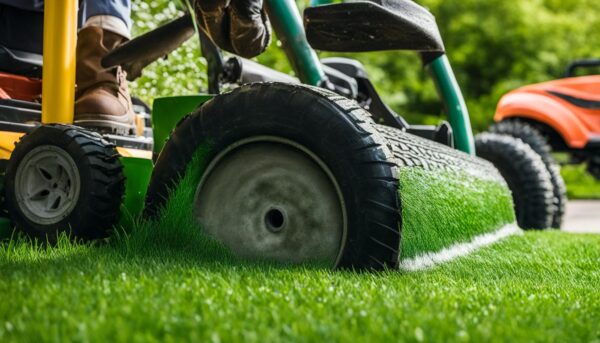
Proper garden tire maintenance is essential for prolonging the lifespan and enhancing the performance of your landscaping equipment. Following a series of best practices, you can ensure that your garden tires remain in optimal condition and perform effectively throughout their service life.
- Regular Cleaning
Keeping your garden tires clean is crucial, as dirt and debris can cause damage and reduce traction. By washing the tires with mild soap and water, you can prevent the buildup of foreign materials.
In addition to cleanliness, it’s essential to maintain the correct tire pressure for your garden equipment. Underinflated or overinflated tires can lead to irregular wear, reduced traction, and poor fuel efficiency. Check your equipment’s user manual to find the optimal tire pressure for your garden tires.
- Inspecting for Wear and Tear
Regular inspections can help identify wear and tear or damage on your garden tires. Look for visible cracks, punctures, uneven wear patterns, or any other signs of damage. Replace or repair any damaged tires as needed.
- Seasonal Maintenance Routine
Following a seasonal maintenance routine can further extend the lifespan of your garden equipment tires.
Examples of seasonal maintenance tasks include:
- Replacing spark plugs
- Stabilizing gasoline before winter storage
- Checking for dry rot or cracking due to temperature changes
By incorporating these best practices for garden tire maintenance into your regular maintenance routine, you can ensure that your lawn mower tire care and other landscaping machinery tire care strategies are effective, contributing to your garden equipment’s long-term success and efficiency.
Replacing vs Repairing: Making the Right Choice for Your Tires
Maintaining the condition of garden equipment tires is essential for any landscaping professional. This includes knowing when to repair or replace a damaged tire. This section will discuss identifying signs of wear and tear in garden tires, how to improve damaged tires, and when to opt for a complete tire change.
Identifying Signs of Wear and Tear on Garden Tires
Regular inspection of tires is crucial for identifying any tire wear and tear and determining if maintenance or replacement is necessary. Some common signs of damage to look for include:
- Frequent flats
- Visible damage, such as cuts or punctures
- Compromised traction due to excessive wear
“Consistent monitoring of your garden equipment tires can help prevent unexpected breakdowns and prolong the life of your landscaping equipment.”
Step-by-Step Guide to Repairing a Damaged Tire
If you discover signs of damage in your garden equipment tire, there are several steps to consider for repairing it:
- Remove the tire from the rim carefully to avoid damaging any surrounding components.
- Locate the puncture, sometimes requiring water immersion for tiny holes.
- Apply a garden equipment tire patching to the affected area, following the patch manufacturer’s instructions.
- Consider replacing or patching the pipe inside for tires with tubes instead of fixing the tire itself.
- Reinstall the tire, making sure everything is aligned correctly and secured.
When to Opt for a Full Tire Replacement
Tire replacement may be a better option than repair in certain situations. It would be best if you considered a complete tire change in the following circumstances:
- Repairs are not sufficient to restore the tire’s functionality.
- The tire experiences significant wear, deep cuts, or irreparable damage.
- Age and degrading rubber have made the tire unreliable.
By keeping an eye out for signs of wear and tear, following a step-by-step guide for repairing damaged garden equipment tires, and knowing when to replace them, you can keep your landscaping equipment running efficiently and ensure the durability and reliability of your tools.
Sourcing High-Quality Garden Equipment Replacement Tires
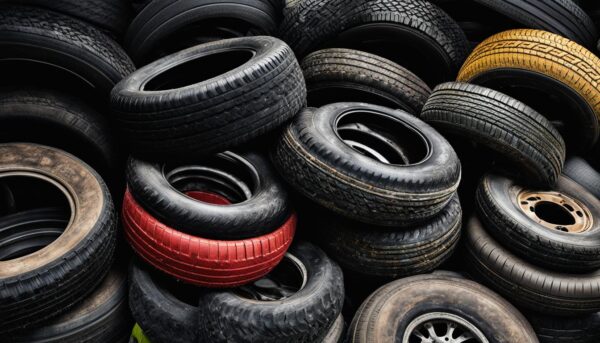
When it’s time to replace your garden equipment tires, it’s essential to source high-quality replacement tires to maintain optimal equipment performance and longevity. Reliable dealers, such as Tires-easy.com, offer a wide range of suitable tires for various garden tools and utility trailers. To make the right choice, it’s crucial to match the tire size and specifications to your equipment’s operational requirements.
There are several factors to consider while sourcing tires, ranging from the types of equipment used, intended terrain, and operational load. The following list highlights popular tire types for specific garden tools:
- Wheelbarrow Tires: pneumatic or semi-pneumatic tires with ribbed treads, providing stability and less turf damage
- Lawn Mower Tires: turf-friendly tires such as Carlisle Turf CTR or WDT P512 based on terrain, offering adequate traction without causing undue lawn damage
- Garden Tractor Tires: tires with appropriate weight capacity and tread pattern depending on the tractor’s intended use
Alongside the listed considerations, it’s essential to verify each tire’s weight capacity and durability to ensure they can withstand the heavy loads and challenging conditions typically encountered by professional landscapers and lawn care companies.
“Proper selection of garden equipment replacement tires involves matching tire size, weight capacity, tread pattern, and durability to your specific equipment and operational requirements.”
One of the best resources for finding high-quality garden tool tires is comparing options available at trusted dealers’ or manufacturers’ websites. In doing so, you can assess the suitability of each tire based on their specifications, reviews, and price.
| Dealer | Popular Garden Equipment Tires Offered |
|---|---|
| Tires-easy.com | Carlisle Turf CTR, WDT P512, Power King D407 Lug, and various “ST” trailer tires |
| Tire Rack | Michelin X Tweel Turf, BKT LG 306, and various lawn tractor tire options |
| SimpleTire | Greenball GBC Motorsports, Deestone D265, and Kenda K500 Super Turf |
By carefully sourcing high-quality replacement tires from reliable dealers and matching them to your garden equipment requirements, you can ensure enhanced equipment performance and durability, ultimately improving your overall work efficiency and results.
Installation Tips for Landscaping Equipment Tires
Efficient tire installation requires the right tools and techniques to make tire maintenance more straightforward and less time-consuming for landscapers and gardeners. This section will discuss the essential tools and effective strategies for installing garden equipment tires.
Tools and Techniques for Efficient Tire Installation
Let’s dive into the necessary tools and techniques needed for successful tire installation:
- Flathead Screwdriver: A flathead screwdriver is one of the most essential tools for prying tires from rims. Keep an appropriately sized flathead screwdriver on hand to make the task easier.
- Tire Irons: Tire irons are critical for removing and setting the tire bead. Select a pair of tire irons for your tire size and type.
- Tire Lubricant: Use a tire lubricant to smooth the tire installation process and prevent any unnecessary rim or tire damage.
- Valve Core Removal Tool: To deflate or inflate the tire accurately, use a valve core removal tool to remove or install the tube’s valve core.
- Tire Pressure Gauge: A reliable tire pressure gauge is a must-have to ensure proper inflation of your garden equipment tire and minimize chances of potential damage.
Tire installation becomes a much more manageable task by integrating the right tools. Here are the best practices to follow using those tools:
- Deflate the tire completely using the valve core removal tool.
- Use the flathead screwdriver to pry the tire off the rim, taking care not to damage the rim or bead.
- Inspect the rim and tire for damage or embedded debris, and remove them if necessary.
- Apply the tire lubricant to the tire and rim, ensuring a smooth installation.
- Position the tire bead onto the edge, using tire irons as needed.
- Check your tire manufacturer’s inflation guidelines, inflate the tire to the recommended pressure using a tire inflator, and regularly check for correct pressure using a tire pressure gauge.
“By using efficient techniques and the appropriate tools, you can greatly simplify the tire installation process, ultimately resulting in less time spent on maintenance and more time spent on landscaping.”
Familiarizing yourself with these tire installation tips and efficient techniques will ensure a seamless experience when maintaining and installing the tires on your garden equipment. Proper tire installation contributes to equipment performance and preserves the life and effectiveness of your garden equipment tire tools.
Conclusion
The key to efficient lawn care for landscapers and professionals is proper garden equipment tire selection, maintenance, and timely replacement. By investing in high-quality tires and ensuring compatibility with the equipment used, professionals can maximize performance and prevent damage to the terrain. Understanding the basics of outdoor equipment tires and the importance of factors like weight capacity, durability, and tread patterns can significantly improve operational efficiency.
Regular care and maintenance, such as cleaning and checking tire pressure, can significantly prolong the lifespan of garden and landscaping equipment. However, when wear and tear becomes evident, choosing between repairing and replacing the damaged tire is crucial for optimal equipment performance. Ensuring correct tire installation and utilizing appropriate tools can simplify tire maintenance for landscaping and lawn care professionals.
In conclusion, the durability and reliability of garden equipment tires can be primarily determined by adherence to the best practices and guidelines discussed in this article. Proper tire management, landscaping, and lawn care professionals will be able to maintain outdoor spaces efficiently and effectively, ensuring satisfaction for both themselves and their clients.
FAQ
What are the different types of garden equipment tires?
Garden equipment tires range from large, heavy-duty trailer tires for hauling heavy loads to smaller tires for wheelbarrows and hand carts. Specific “ST” trailer tires are recommended for commercial trailers, while pneumatic tires are preferred for commercial wheelbarrows. Ride-on mower and tractor tires must be chosen based on lawn surface and required traction.
How do I select the correct tire size and compatibility for my garden equipment?
Tire size selection involves matching the tire specifications to the operational requirements of the equipment. For example, utility and equipment trailers typically use sizes like ST225/75R15 and ST205/75R15, while wheelbarrows and hand-cart tires often have measures such as “4.00 – 6.” Compatibility is essential for maximizing equipment performance and longevity.
Which tread patterns are best for different types of terrain?
Tread patterns should be chosen based on the terrain. Tires with sufficient traction, like the WDT P512 tire, are necessary for hilly or wet terrain. A less aggressive tread, such as a ribbed pattern or the Carlisle Turf CTR Tire, may be more suitable for flat and dry areas.
How can I maximize the performance and longevity of my lawn equipment tires?
Proper maintenance of garden equipment tires includes regular tire pressure checks, cleaning, and inspecting for wear and tear. Maintaining the mower deck and ensuring clean and sharp blades can also maximize performance and longevity.
What are the best practices for garden tire maintenance?
Garden tire maintenance best practices include cleaning, ensuring correct tire pressure, inspecting for wear and tear, and following a seasonal maintenance routine, such as replacing spark plugs or stabilizing gasoline before winter storage.
When should I repair a damaged tire, and when should I replace it?
Repairing a tire is suitable when the damage is minimal, such as a tiny puncture or leak. A complete tire replacement is necessary when repairs are insufficient; the tire has significant wear-deep cuts or is unreliable due to age and degrading rubber.
Where can I source high-quality garden equipment replacement tires?
High-quality replacement tires can be sourced from reliable dealers like Tires-easy.com, which offers a range of tires suitable for various types of garden equipment and utility trailers.
What tools and techniques are needed for efficient tire installation?
Installing garden equipment tires efficiently requires tools like flathead screwdrivers for prying tires from rims and techniques such as checking for embedded debris before reinserting the tube. Proper tools and techniques can make tire maintenance more straightforward and less time-consuming for landscapers and gardeners.





